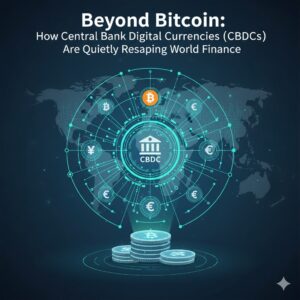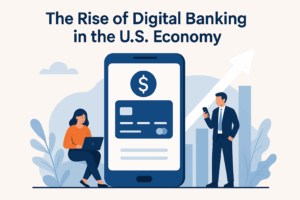
The Ascendancy of Digital Banking and Its Effects on the U.S. Economy
The U.S. financial services arena has been experiencing an unprecedented revolution over the past few years due to the explosion of digital banks. Not too long ago, banking services and platforms such as mobile-first banks and app-based financial software were a niche convenience, but now, they’re essential characters in the world’s economy. Digital or “neobanks” provide convenient and user-friendly solutions for a generation of consumers who want fast, on-demand service that is transparent. Not held back by physical branches and legacy systems the way traditional banks are, digital ones mostly exist online, meaning they can trim costs and pass on savings in the form of lower fees as well as more competitive interest rates.
While it’s great for consumers, what are the implications of digital banking on world finance? With the process of sending money abroad made easier, and with cryptocurrencies becoming more intertwined in digital platforms than ever before, global finance is fully interwoven. Cross-border transactions can be handled instantaneously by consumers, businesses can compete in a new market unfettered geographically, and investors are able to create diverse portfolios with the click of a mouse.
Not only is this redefining banking, but it’s also providing opportunities for economic inclusion. Millions of underbanked Americans have access to affordable financial services through mobile apps. The rise of digital banking also adds to the dynamism, resilience and innovation of fintech, which enhances financial flows and efficiency for the global economy.
But as digital banking expands, it also is met with issues like cybersecurity threats, consumer confidence and regulatory adherence. However, its merits far outweigh its demerits, and it is one of the major impelling factors that are shaping the direction of future world finance.

The Advantages of Online Banking
How Adopting Technology Can Benefit Your Financial Future
4 Curiosities and Persuasive Tips
Worldwide Access on Your Palm – In the age of digital banking, transferring money abroad is as simple as sending a text. This enables “twinning” through the Internet, which is time-saving and cost-effective for citizens as well as for businesses that engage in international trade.
Cheaper with More Rewards – Most challenger banks operate more efficiently and on much lower costs, which they pass onto you in the form of higher interest rates, cashback offers, and lower fees.
Banking For All – Tens of millions of Americans who prior did not have access to the banking system now do so through their mobile devices, leading to greater economic inclusion.
Quicker Innovation – Digital banks often quickly bring new features to market (such as AI-fuelled savings tools, budgeting trackers and crypto wallets) that empower customers with greater control so they can grow financially.
Obstacles to Overcome Before Going Fully Digital for Banking
2 Disadvantages
Digital banking offers some significant advantages, but there are also pros and cons you would be remiss to ignore.
First, it still puts cybersecurity in jeopardy. Even online platforms can be hacked, and while banks spend fortunes on security, no system is entirely impregnable. This is not to say that digital banking is unsafe, but customers must take the extra step of enabling two-factor authentication and monitoring accounts frequently.
Second, for some users it is a disadvantage that there is no physical interaction. Customers used to in-branch banking may prefer not to switch over to a digital-only player, especially when dealing with complicated financial issues. With 24/7 chat support and video consults entering the mainstream, though, this is slowly but surely being solved.
One of the biggest financial innovations in the 21st century that has reshaped how people, companies and governments deal with money is digital banking. In the United States, the evolution from traditional branch banking to app-based banking doesn’t just reflect a shift in consumer habits; it’s also part of a broader global trend toward faster and more efficient financial systems. The emergence of neobanks, mobile wallets and fintech solutions has made it simple for individuals to save, invest, transfer and borrow money without limitation of geography.
The promise it brings ranges from greater financial inclusion for underbanked economies, all the way to turbocharging global commerce with boundary-less cross-border payments, as digital banking is transforming the landscape of world finance. And, while it raises issues such as cyber threats and loss of face-to-face engagement, the potential for innovation, accessibility and economic participation are too great to deny. As we see tech change, digital banking is here to stay for life-long financial momentum, globally.
Our Post


Beyond Budgeting: Master Your Money with the Power of Conscious Spending

